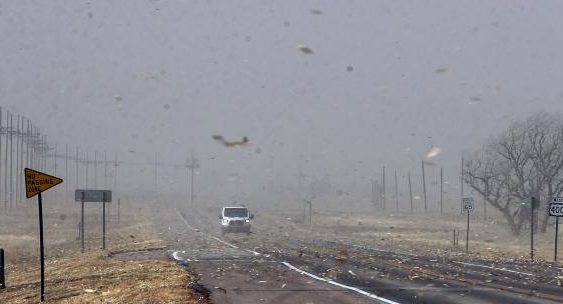Strong winds blow warmth, chance of tornadoes into Midwest

OMAHA, Neb. — A powerful storm system ushered in strong winds, heavy rain and a chance of tornadoes across the Great Plains and Midwest on Wednesday, with temperatures posed to set record highs in some places only days before the official start of winter.
Forecasters predicted likely record-breaking high temperatures in the mid-70s for much of Nebraska, Kansas, Iowa and parts of Missouri. The warmth came with dangerous winds and threats of violent storms, on the heels of devastating tornadoes last weekend that cut a path through states including Arkansas, Missouri, Tennessee, Illinois and Kentucky, killing at least 88 people.
The National Weather Service issued a high wind warning for an area stretching from New Mexico to upper Michigan — including Wisconsin and Illinois. Gusts topping 80 mph (129 kph) were recorded in the Texas Panhandle and western Kansas. The National Weather Service said an automated observation site in Lamar, Colorado, recorded a gust of 107 mph (172 kph) Wednesday morning.
The high winds whipped up dust storms that reduced visibility to zero west of Wakeeney, Kansas, the state Department of Transportation said, and caused at least four semitrailers to blow over. Kansas officials closed Interstate 70 from the Colorado border to Hay, as well as several other roads.
Officials also warned of a dangerous fire risk along the western edge of the weather system, where conditions were dry.
“Essentially, if there are any fires today, it’s going to be next to impossible — if not impossible — to keep them under control, just because of the wind,” National Weather Service meteorologist Jordan Thies, based Hastings, Nebraska, said. “For our neck of the woods, this is about as bad as it gets.”
Scientists say extreme weather events and warmer temperatures, much like what’s happening, are more likely to occur with human-caused climate change. However, scientifically attributing a specific event like this storm sytem to global warming requires specific analysis and computer simulations that take time, haven’t been done and sometimes show no clear connection
Damaging winds were likely to bring down trees and power lines, leading to power outages, the weather service warned. Some schools in Kansas and Nebraska canceled in-person classes, and dozens of schools in Iowa and Nebraska were closing early in anticipation of bad weather.
In the Southwest, strong winds took down power lines in Shiprock, New Mexico, knocking out power to residents across the Navajo Nation.
National Weather Service meteorologist Alex Ferguson, based in Amarillo, Texas, described the system as a “pretty quick-hitting wind storm.” Blowing dust drastically cutting visibility in the Texas Panhandle, where Sherman County Sheriff Ted Allen said all roads in and out of the county had been closed. In the Oklahoma Panhandle, the state Department of Transportation reported the main road north from Boise City into Colorado was closed because of collisions and downed power lines.
Officials urged people to bring in or secure holiday decorations, trash cans and outdoor furniture, which they said could become hazardous projectiles in the strong winds.
The winds and storms were expected to move quickly east, Thies said. After that, forecasters expect temperatures to plunge, with below freezing tempetures in the northern Plains.
___
Associated Press writers Ken Miller, based in Oklahoma City, Margaret Stafford, based in Kansas City, Missouri, and Terry Wallace, based in Dallas, contributed to this report.